Types of currencies: from fiat to crypto
Almost every adult is familiar with the term “currency”. Whenever we travel abroad, make international purchases, or transfer money between countries, we have to deal with currency exchange.
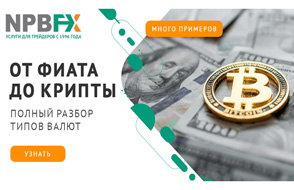
For example, tourists traveling to another country exchange their native money for local currency to pay for goods and services.
In the world of finance, currencies play a key role in enabling the exchange of goods and services around the world.
However, few people think that currencies can not only be exchanged for personal needs, but also make money on the difference in their rates.
This becomes possible thanks to the international over-the-counter currency market - Forex.
Unlike standard currency exchange at a bank, Forex trading allows you to earn income from exchange rate changes in real time (24/5), using various types of currencies: it is enough to have a computer or smartphone with Internet access.
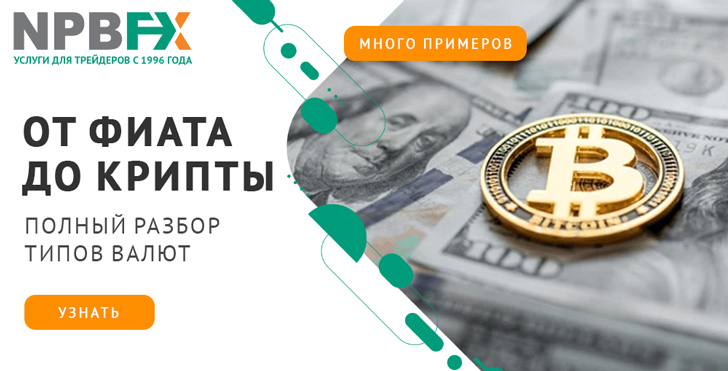
Today we will introduce you to currencies in more detail, tell you about their different types, features and advantages. We will also discuss where and how you can trade different types of currencies. The information partner of the material is the international STP/NDD broker NPBFX (NEFTEPROMBANKFX).
A brief history of the emergence of currencies
Let's start with a short excursion into history. Currency as a medium of exchange existed long before the modern money we use today was created. In ancient times, people exchanged goods and services directly - this was called barter trade. However, barter had its disadvantages, such as the difficulty in determining the equivalent value of different goods and the need for a coincidence of needs between the parties to the exchange.
The first prototypes of currencies appeared when people began to use goods that were accepted by everyone and had a stable value, such as grain, shells, and cattle. Over time, gold and silver became the primary means of exchange due to their rarity, durability, and divisibility.
The real revolution in the history of currencies occurred with the invention of coins and then paper money. The first coins began to be minted in the Lydian kingdom (modern Türkiye) around 600 BC. Over time, monetary systems became more complex, national currencies backed by the gold standard appeared, and then fiat currencies that were not directly backed by precious metals.
Today, currencies exist in various forms, from traditional fiat money to digital currencies such as cryptocurrencies. Each of these forms has its own characteristics and plays its role in the global economy.
Types of currencies
#1. Fiat currencies
Fiat currency is money that has no intrinsic value but is recognized as legal tender by the government. Their value is based solely on trust in the government and the economic stability of the country. Examples of fiat currencies include US dollar (USD), euro (EUR), ruble (RUB), yen (JPY).
Advantages:
- Widely accepted and used in most countries of the world.
- They are supported by the state and central banks, which ensures their stability.
- Easy to use in everyday life for shopping, paying for services and storing savings.
Flaws:
- Subject to inflation, which can reduce purchasing power over time.
- In the event of an economic crisis, they may depreciate sharply.
- Subject to the control of governments, which may impose restrictions on use.
#2. Cryptocurrencies
Cryptocurrencies are digital or virtual currencies that use cryptography to secure transactions and create new units. They are decentralized and operate on blockchain technology. Examples of cryptocurrencies include Bitcoin (BTC), Ether (ETH), Litecoin (LTC).
Advantages:
- Decentralization is the absence of a central body that controls emissions and management.
- Anonymity and high degree of confidentiality.
- Global access and the ability to conduct international transactions with low fees.
Flaws:
- High volatility, which can lead to both large profits and large losses.
- Limited acceptance as a means of payment.
- Lack of legal regulation and risk of use for illegal purposes.
#3. Electronic money
Electronic money is funds stored in electronic systems that are used to make online payments. This can be either fiat money transferred to digital form or funds in electronic wallets. Examples: PayPal, Yandex.Money, QIWI.
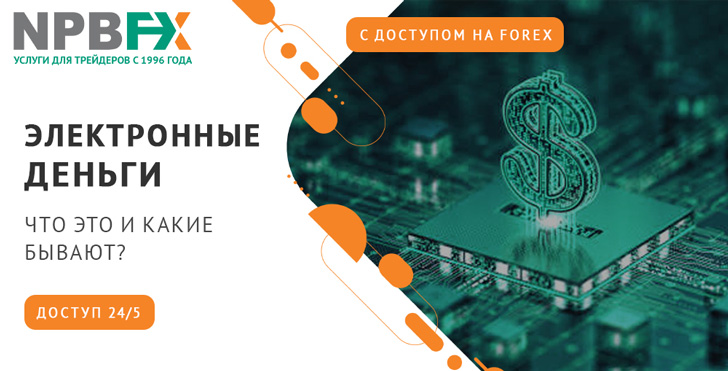
Advantages:
- Ease of use for online shopping and payments.
- High transaction speed.
- Wide acceptance by online stores and services.
Flaws:
- Dependency on technology and internet connection.
- Potential risks of cyber attacks and fraud.
- Commissions for transfers and withdrawals.
#4. Commodity money
Commodity money is physical goods that are used as currency. In ancient times, such goods included gold, silver, shells, and later gold and silver in the form of coins. Today, commoditized money in its classical form is practically not used, but gold and silver continue to be important assets, as mentioned above.
Advantages:
- High intrinsic value, especially in precious metals.
- Resistance to inflation and the ability to serve as a reliable store of value.
Flaws:
- Difficult to use for everyday transactions.
- Limited possibilities for crushing and divisibility.
- Risk of physical damage or loss.
Local currencies
Local currencies are currencies that are accepted for payment only in a specific geographic area or community. They are usually used as a complement to national currencies to support local economies. Examples: Bristol pound in Great Britain, Bavarian thaler in Germany.
Advantages:
- Supporting the local economy and small businesses.
- Reduced dependence on the national currency.
- Strengthening the local community.
Flaws:
- Limited area of use.
- Low liquidity and difficulty in exchanging for national currencies.
- Risks in case of depreciation or cessation of existence.
Currencies in trading on financial markets
Trading currencies in the financial markets has become extremely popular due to its accessibility and potential for profit. One of the main factors attracting traders is the high liquidity of the Forex currency market, which is the largest financial market in the world with a daily turnover of more than $6 trillion.
Currency trading allows traders to speculate on changes in exchange rates using various strategies such as short-term trades (scalping), long-term investments and automated trading. Currencies are also often used as a risk hedge in international trade.
Popular trading tools include:
- Currency pairs (for example, EUR/USD, GBP/JPY)
- Cryptocurrency pairs (for example, BTC/USD, ETH/EUR)
- Metals (eg gold, silver) as tools in trade.
Modern brokerage companies, which act as intermediaries between the financial market and the retail trader, offer the opportunity to use margin (leverage) leverage in trading various types of currencies. This is an opportunity to trade with an amount significantly exceeding your own funds. For example, using a margin of 1:1000, a trader with $1,000 available can trade $1 million.
Essentially, the brokerage company credits your trading. However, here you need to understand that both profit and loss will be proportional to this amount. Therefore, it is extremely important to strictly adhere to risk management.
Let us give a clear example of such a currency transaction. Pay attention to the graph below:
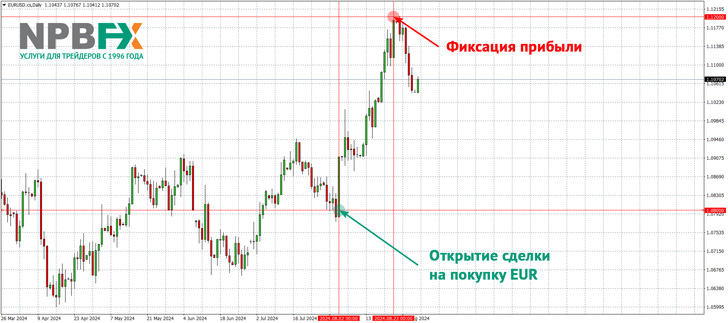
A trader using a margin leverage of 1:1000 opened a Buy EURUSD trade with a volume of 1 standard lot at a price of 1.0800. In simple terms, I bought 100,000 euros. After 21 days, the trader sold the euro at the rate of 1.12 US dollars per 1 euro. The profit during this time was $4,000.
Conclusion
Trading currencies offers unique opportunities, but also requires knowledge and experience. It is important to choose a reliable broker for trading and trading training.
NPBFX is one of the leading brokers that provides favorable conditions for trading on Forex with instruments of five markets: fiat currencies, cryptocurrencies, precious metals, stocks and indices, and raw materials. Among the advantages of the broker:
- High reliability - on the market since 1996, 20 years of banking experience.
- Access to the interbank market using STP/NDD technology, eliminating conflicts of interest.
- Tier 1 liquidity providers (large global banks and ECN systems).
- Modern trading platform Metatrader 4, including a mobile application and WEB terminal.
- Professional analytics and customer support in 8 languages.
- The highest Category A in The Financial Commission, allowing traders to receive a payment of up to 20,000 euros in case of disputes with the broker.
- Serving traders from the Russian Federation with the ability to deposit/withdraw money in more than 20 ways.
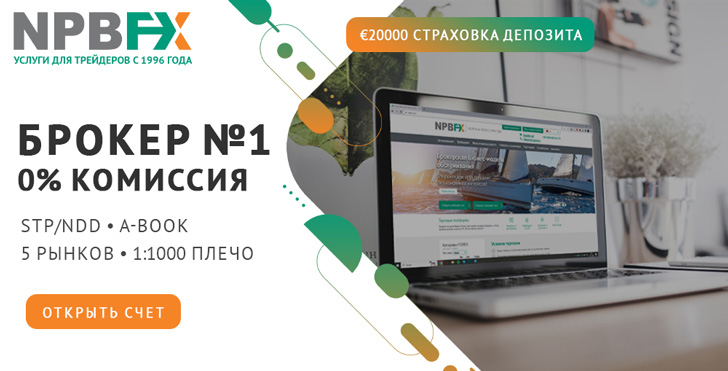
We recommend that you start trading with NPBFX to reap all the benefits of working with a professional brokerage. Register and open an account right now - take the first step towards successful trading in the financial markets!
